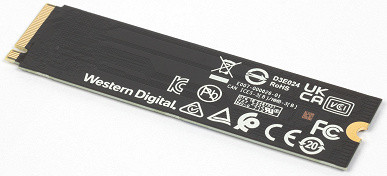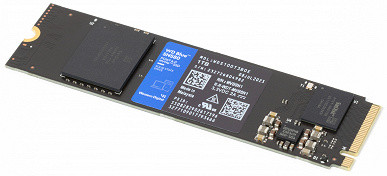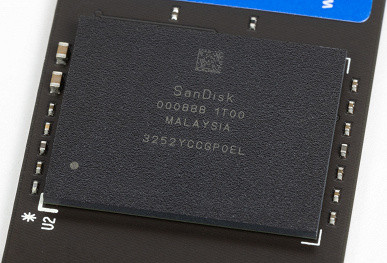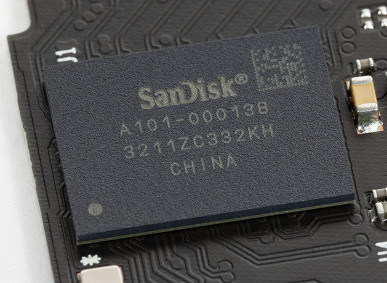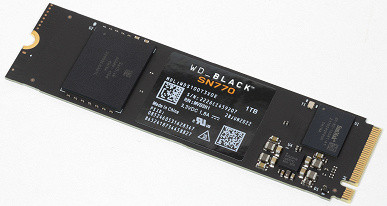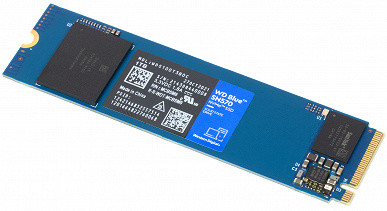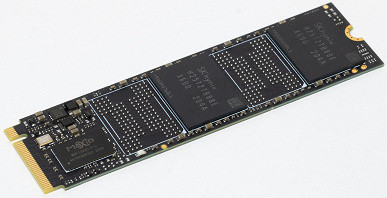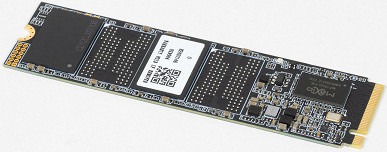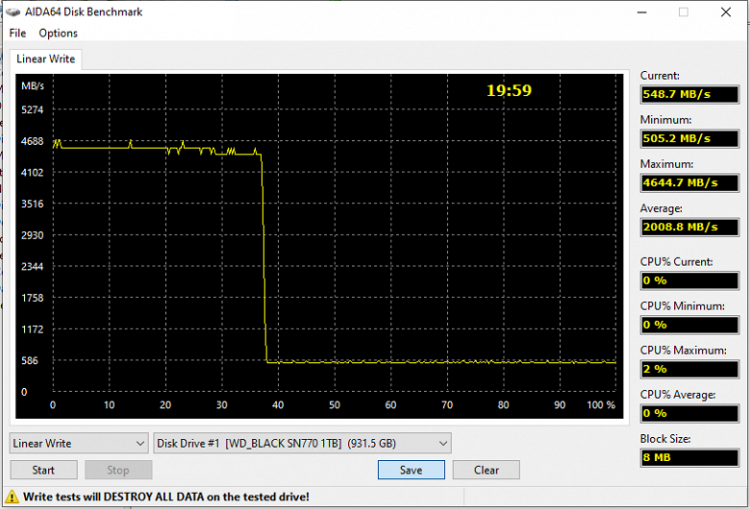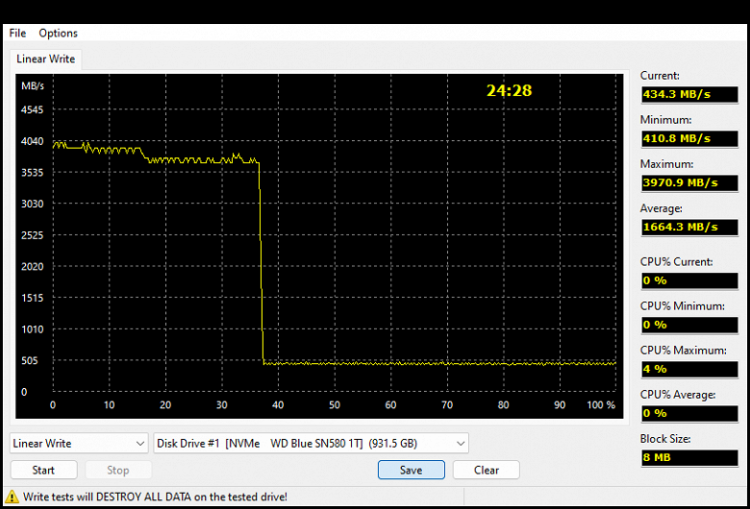While enthusiasts are waiting for new PCIe Gen5 SSD controllers to appear, which are aimed at correcting the shortcomings of the first generation, the mass market is completing the transition from Gen3 to Gen4. There are still remnants of old platforms on the market, which will eventually disappear along with their legacy controllers and memory. These old SSDs are sold at low prices, which makes them attractive to buyers, although they do not provide record performance. However, such drives do not create unexpected problems, such as QLC memory, especially in the budget segment. However, such cases are becoming increasingly rare. Stocks of legacy controllers and memory are running low, and the number of computers that do not support PCIe Gen4 is decreasing, making it easier to sell modern SSDs, even budget models. In this context, a significant event last year was the announcement and start of sales of the WD Blue SN580 — the first SSD from the Blue line with PCIe Gen4 support, which was previously available only for the senior Black line. While the Blue SN580's speeds aren't quite up to par with its big brother, they're still important to the market.
The primary reason for the Blue SN580 was OEM demand. OEMs are eagerly buying these drives because modern platforms from AMD and Intel support PCIe Gen4, and customers want to see this support in the specs. The SN740 and SN810/SN820 were previously used for this purpose, but they were still expensive. In the case of the Blue SN580, this doesn't matter much, as it still has sufficient performance, reaching 4,150 MB/s when reading and writing data.
There are also technical reasons for the new model. While everyone is used to the fact that maximum speeds are achieved only within the SLC cache, its size still matters. The static SLC caching used in the SN570 series is outdated. The increase in the capacity of the memory crystals has also reduced the WD Blue's ability to write data «behind the cache». At the same time, all NVMe SSDs from WD have switched to dynamic caching in recent years, with the exception of the Blue, which needed a new controller.
WD could have simply lowered the price of the Black SN770, but that would have created a problem with what to sell instead. So it decided to release a new model, which is essentially a temporary solution. This summer, the company announced the WD Blue SN5000, which replaces the WD Green SN350 in the range and is based on the new 162-layer BiCS6 QLC memory. The other models use the «old» 112-layer BiCS5 TLC memory, which provides declared speeds of up to 5150 MB/s when reading and 4900 MB/s when writing. Recall that for the SN580, «only» 4150 MB/s were declared, and the SN570 is limited to PCIe Gen3.
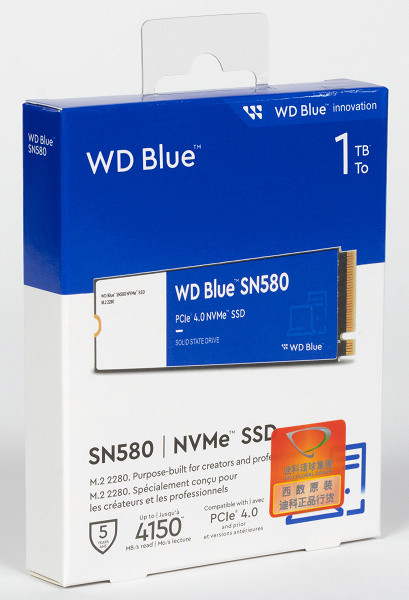
So, if we consider only the development of the Blue line, the WD Blue SN580 is another step forward. Previously, all the “blue” SSDs were SATA only, then two models on PCIe Gen3 (SN500) appeared, then four (SN550 and SN570), then there was a transition beyond Gen3 (SN580), and now they are more fully mastering Gen4 with the release of the SN5000. However, if we take into account the “light black” series, the picture becomes more complicated.
It is interesting to see what the Blue SN580 can offer with its modest sequential speeds, which in practice are not as important as many have already realized. It is important to consider how it compares with the SN570 and SN770, as well as the SN5000, which has not yet reached our region. Where it is already available, its price is higher than the SN770, not to mention the SN580, which is quite natural for a new product.
The question remains: should we expect the SN5000 and is it worth paying attention to the SN570? Tests and a more detailed study of the drive's capabilities will help answer these questions.
WD Blue SN580 1 TB
Modern M.2 SSDs are usually similar in appearance, but WD's models always stand out from the competition. The company uses a single chip to package the flash memory, regardless of the board size, which leaves plenty of room on the 2280. As a result, we see a noticeable change in the color of the board — it's black, as opposed to the bluish tones of previous Blue models, making it more similar to the Black. In addition, the layout of the components on the board is also reminiscent of the SN770.
Interestingly, on some SN580 models we found the controller marking identical to that used in the SN770. However, in our case we came across a chip with a different marking: instead of the usual 80-82… sequence, it starts with A101. This is reminiscent of the latest versions of WD Blue SA510 and Green SATA drives, although the controller in this case is different.
However, do not jump to conclusions. WD's markings can be quite confusing. In our testing, there were two Blue SN550 models and one SN570 with the same controller marking, but the first two worked similarly, while the third showed completely different results. Sometimes, different markings are found in the same SSD line, but the general rule remains: SN550 and SN570 cannot be confused in operation, and two copies of the same model will behave the same regardless of the marking. This is probably true for all Blue SN580s as well — they should work similarly regardless of the controller label, but still differ from the Black SN770 even with similar numbers.
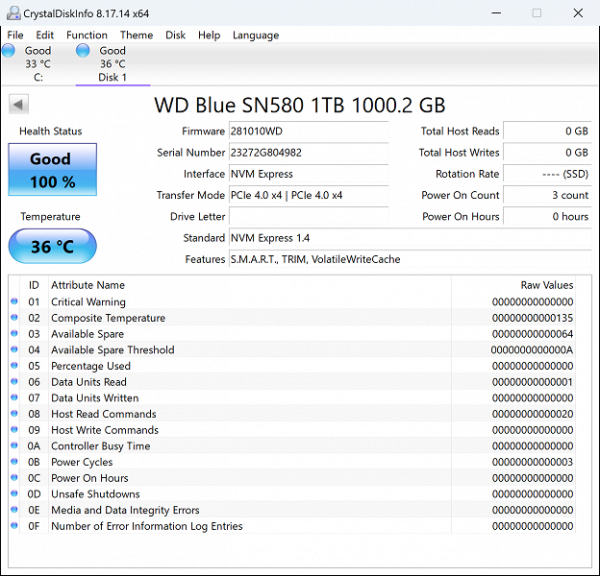
So, let's move on to testing. SSDs from major manufacturers using their own components can be considered «black boxes». Unlike open-market controllers, where third-party diagnostic utilities based on leaked firmware source codes exist, access to internal information is usually limited. However, the variety of configurations is also small, which allows test results to remain relevant for a long time. However, it is important to keep an eye on changes — the recent case of a decrease in write speed in the Blue SN550 caused quite a stir. This does not apply to the constant improvements to the Blue 3D SATA line, which have gone virtually unnoticed. In response to the Blue SN550 situation, WD promised not to allow such changes without changing the model names, and so far they have kept their word.
Testing
Testing methodology
We conduct testing on a stand with an Intel Core i9-11900K processor and an Asus ROG Maximus XIII Hero motherboard on the Intel Z590 chipset, which provides two ways to connect an SSD — via the «processor» PCIe Gen4 lines and the «chipset» PCIe Gen3 lines. The first option allows modern SSDs to operate at full capacity. However, the «compatibility mode» is also of interest, since the PCIe controller on the chipset appeared in the Intel «hundredth» series chips (2015) and has not undergone any fundamental changes. Therefore, the owner of an old computer will get similar results if he decides to install a modern drive. This makes sense: modern mid-range models often outperform outdated flagships, and PCIe Gen4 is not the only advantage of new SSDs. To fully understand the situation, it is necessary to conduct tests.
Samples for comparison
The main benchmarks for comparison will be the WD Blue SN570 and Black SN770. At first glance, the Blue SN580 looks like a slower version of the latter, but is officially considered an evolution of the former. At the same time, the supply of SN570 did not stop after the release of SN580, and the remaining ones are still being sold out. Therefore, many users preferred the time-tested solution, especially when upgrading computers that do not support PCIe Gen4. Today, we will check how justified this decision was.
Although we could limit ourselves to the models mentioned above, we decided to add a couple more alternatives for the sake of completeness. The first of these is the Ardor Gaming Ally AL1288, based on the Maxio MAP1202 and equipped with 128-layer SK Hynix memory. This platform is well-researched and, like the WD Blue SN570, only supports PCIe Gen3. In addition, we will take the Digma Meta M6E, which uses a newer MAP1602 controller with PCIe Gen4 support and 176-layer Hynix memory. Although the brands of these drives are on different levels, practical nuances also matter.
WD, along with several other global brands, left the Russian market a few years ago, and now all deliveries are made only through parallel imports. Due to the lack of support from the manufacturer, importers cannot guarantee long warranty periods, which explains the typical one-year warranty in most stores. A year ago, flash drives were inexpensive due to the overproduction crisis, and many buyers were ready to turn a blind eye to this, choosing proven brands. However, as prices rose, so did the number of people willing to save a little by taking a chance on lesser-known brands. In addition, they can offer normal warranty periods of five years — in case of failure, the SSD can be replaced or refunded. If you are lucky, you can save money. But how all this affects performance is an important question, since saving can be risky during operation. Although, as previous tests show, in the middle class such problems rarely arise, and an extra comparison will always be useful.
Filling in data
The graphs show similar quality, but differ in quantitative indicators: Blue SN580 is slightly slower than Black SN770 in both areas. As for the SLC cache, this is quite expected — the 1TB version of the «light black» drive has a write speed of 4900 MB / s, while the «blue» is limited to 4150 MB / s both when reading and writing. It seems that this limitation is artificial — the controller is simply not allowed to overclock higher.
How does this compare with the lower write speed outside the SLC cache? Actually, it is quite logical. We have previously observed something similar when testing the OEM version of the Black SN770 — the PC SN740 drive in the M.2 2230 format. The difference in speed is almost identical to within a few megabytes per second. Therefore, these indicators may vary depending on the delivery date and a specific batch of memory, but the manufacturer does not make any promises about their stability. Also, a small controller latency could have affected the results: the process of compacting old data while writing new data is more complex than simply writing to cache.
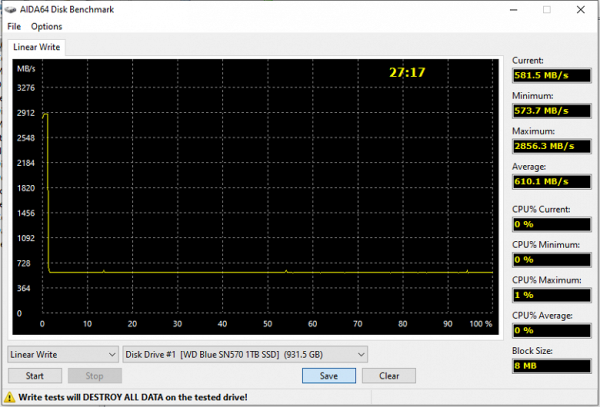
The main thing is that the Blue SN580 and SN570 have nothing else in common. The SN580 has the highest write speed outside of the SLC cache among WD's budget SSDs, but the cache itself is already considered slow by today's standards and too small to significantly affect overall performance. In some cases, you can «cheat» low-level benchmarks or temporarily capture a file, but this is not enough. Therefore, a completely static scheme, although simple and attractive, has long been outdated in most tasks. WD was one of the last major manufacturers to adhere to this scheme until last year, but abandoned it in the same period.
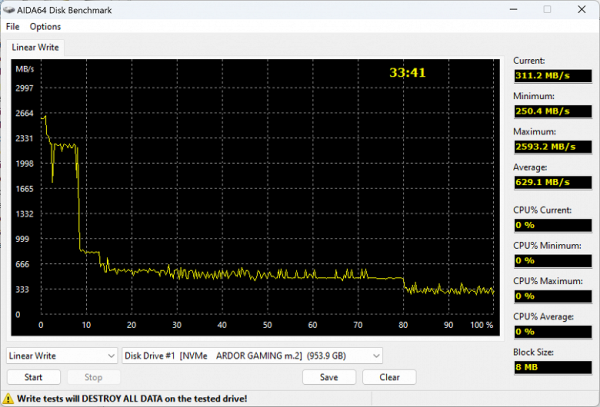
In fact, static solutions have long had worthy competitors not only among the largest controller developers. During the period of dominance of MAP1202 and its analogues, WD did not have to worry — the full write speed was limited only by a small static part of the SLC cache, and even that was lower. Direct write was slower, and the minimum speeds were noticeably lower. However, it is easier to hit the cache, and the speed here is four times higher than with direct write with WD, which allows the drive to process requests faster and go into sleep mode faster (which is especially important for laptops, where the balance between working time and idle time is important).
When SSDs based on MAP1602 and second-generation controllers from Phison and Silicon Motion began to appear on the market, the «blue» WD began to look too pale. Firstly, due to the lack of Gen4 support, even on paper. Secondly, more than half of their capacity can be written at speeds above 2 GB/s. The minimum write speed, although slightly higher than that of the Blue SN570, still takes time to reach.
That's why it was decided to release a new model, replacing the Blue SN570. This is already the second version, now without restrictions, which makes the existence of the Black SN770 a little strange, but logical — last year it made no sense to change it, and now it seems the time has come. Given the positioning of the Black, it is not as afraid of competition with inexpensive Chinese analogues as mass models. Therefore, the update began with the Blue, although so far it has not brought anything really new.
Maximum speed characteristics
Low-level benchmarks, including CrystalDiskMark 8.0.1, have long been victims of the unequal battle with SLC caching, which limits their testing capabilities to the cache itself. However, the information provided by manufacturers about the performance of devices is also often limited by the limits of this cache, so it is useful to conduct tests. It is important to note that all work on caching optimization is aimed at «hitting the cache» as often as possible in real-world conditions, demonstrating high speeds even with decreasing memory costs.
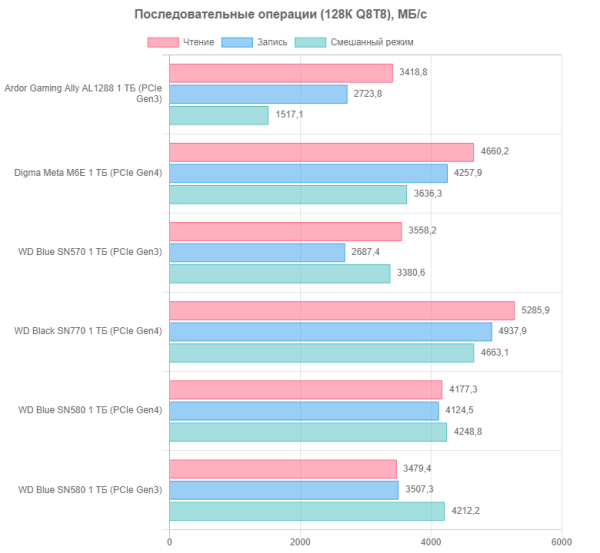
WD is very precise in their specifications, which is why they present them in this form. The difference between the SN580 and SN570 is obvious, and the latter has advantages even in simple scenarios under the same operating conditions. Although in testing conditions, Gen4 does not provide significant advantages. The key point is that the Blue SN570 performed well against competitors using similar unbuffered quad-channel Gen3 controllers, but further development was already necessary last year.
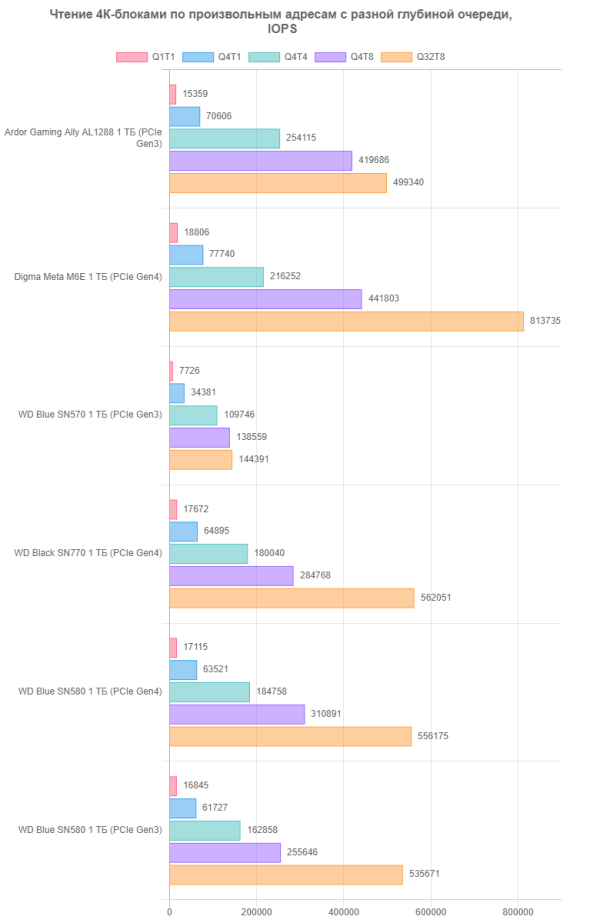
Funnily enough, the difference between the SN580 and SN770 is becoming hard to spot. This is not surprising, since the focus is on the controller and its performance when working with SLC cache, many manufacturers may have different read speeds from cache and main memory array. At the same time, the SN570 has nothing in common with these models. However, it has never been a record holder in this category. The fact is that WD focused its efforts on optimizing real-world use cases, and not on synthetic tests with small queues. Without queues, performance is interesting, but only up to a certain limit, which even the old line of controllers, dating back to the SN500 from pre-pandemic times, easily overcame.
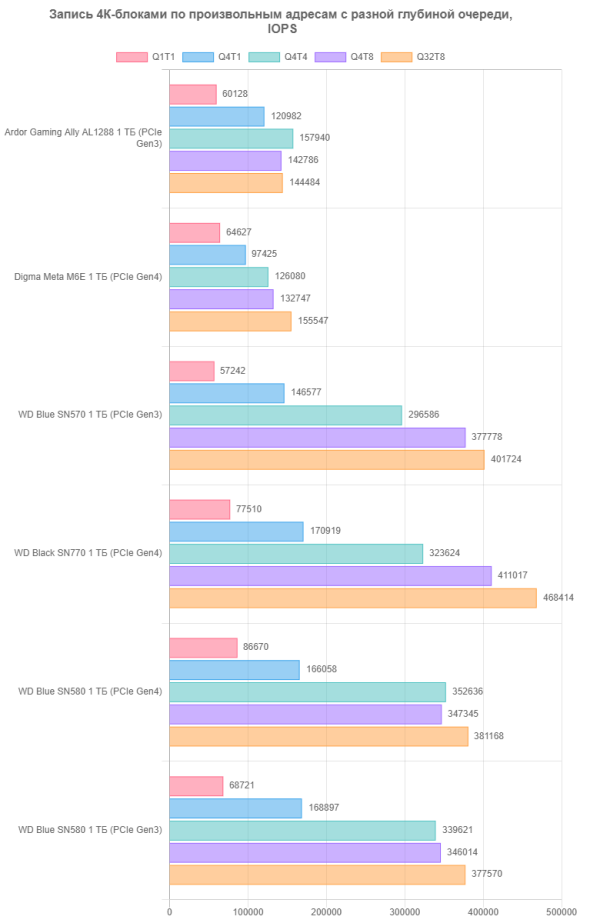
A true remark about the synthetic nature of the tests. Indeed, one can see that all WD models are quite similar in any operating mode. However, the Maxio controller has always had problems with such loads, so its results are not the best guide. Apart from the fact that this is a kind of high-performance sport, we conduct such tests because for some users their results are interesting as additional information that contributes to general education.
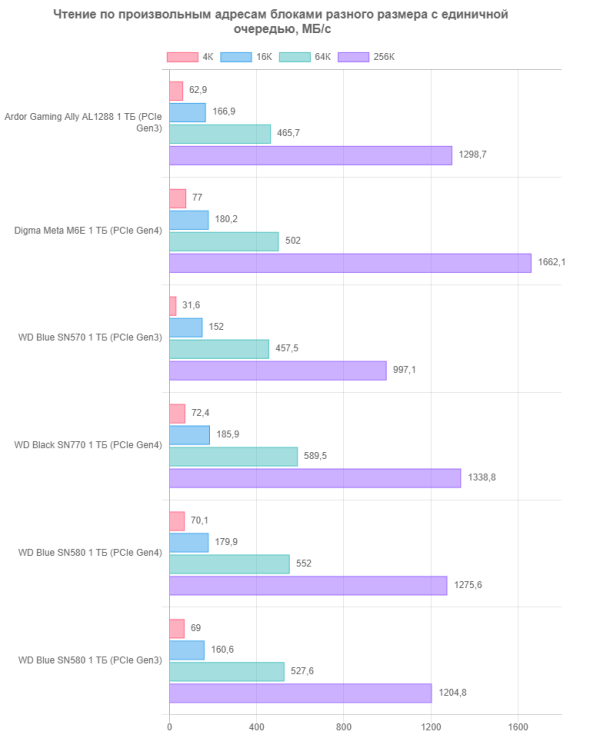
Such operations have a much greater impact on the performance of real software than the previous tests: “long” queues are almost never encountered in practice, while data blocks other than 4K bytes are quite common. Although the number of operations per second on “large” blocks is slightly reduced, their size is larger, which leads to a higher resulting speed in megabytes per second. Therefore, everyone tries to work with such blocks. Here again, we see a relatively small difference between the SN580 and SN770 compared to the SN570. However, the latter was not bad even among PCIe Gen3 controllers, and it is time to move on.
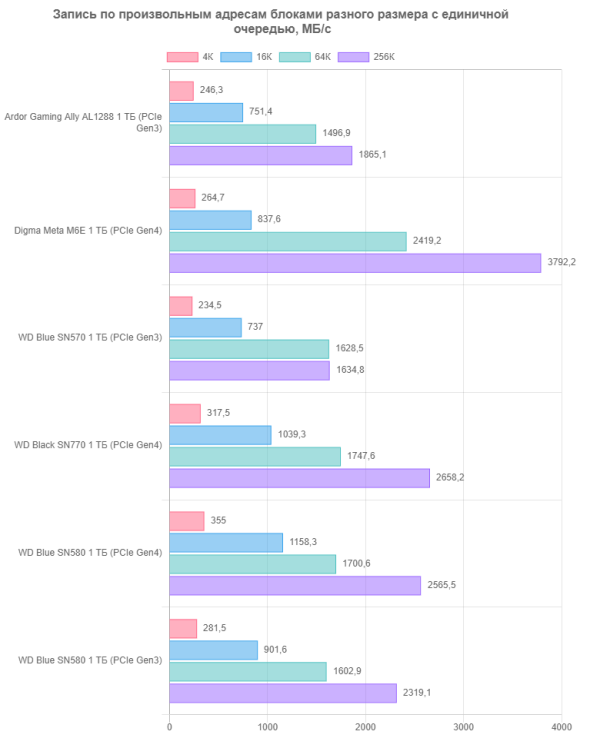
In this scenario, the difference becomes even more noticeable. To be fair, many competitors have advanced further, but this is mainly due to potential capabilities. In fact, the Blue SN570 has not lost its relevance in terms of working with mass application software. To lose in the competitive struggle, it is not necessary to be bad — it is enough to show slightly worse results. This is especially true for tests that many buyers pay attention to before buying. Especially if we are talking not about something small and cheap, where the choice is mainly based on price, but about a more serious purchase, such as a mid-range terabyte SSD.
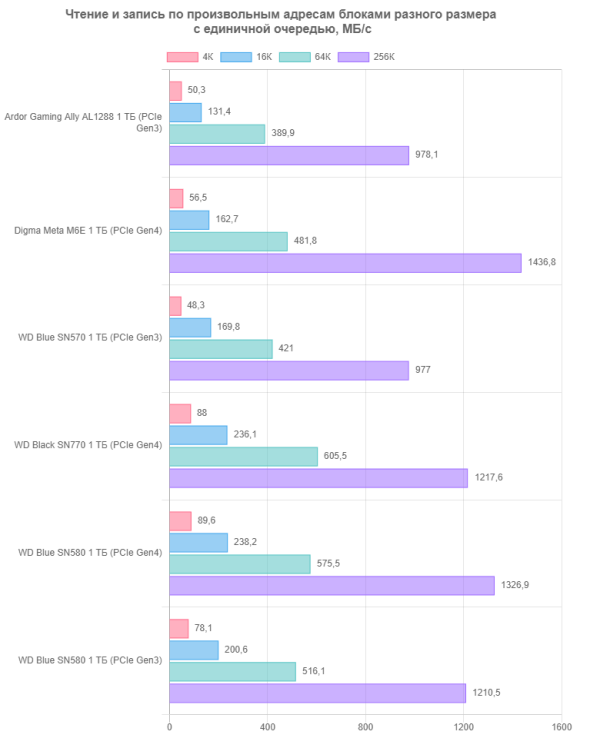
Mixed mode is also important, as in real-world conditions (unlike benchmark utilities), there is rarely a situation where data is only written or only read. This is especially noticeable in a multitasking environment, given the complex processes that occur in modern operating systems. However, there is nothing particularly interesting here. In essence, the Blue SN580 is the same model as the Black SN770, but with a slightly reduced peak performance. This simple and straightforward approach does not affect the speeds in mixed scenarios. So this is a clear step up from previous Blue models, and we would not be surprised if all SSDs from the 500 and 700 series cost the company the same price.
Working with large files
Despite impressive results in low-level utilities, it is not always possible to achieve the same speeds in real conditions. This is due to the fact that tests such as CrystalDiskMark work with small (relatively) amounts of data within a single file. Firstly, in modern conditions, such data is almost always in the SLC cache throughout the entire test. Secondly, service operations of the file system are not taken into account: writing one file implies modification of the file allocation table (MFT) and journals (especially in journaling file systems such as NTFS). Thus, writing is not done sequentially in one place, but is broken down into many small operations. For more practical accuracy, it is better to use the Intel NAS Performance Toolkit, which allows you to test not only the cache, but also the device in conditions close to real ones, when there is almost no free space. This is exactly how we conduct tests.
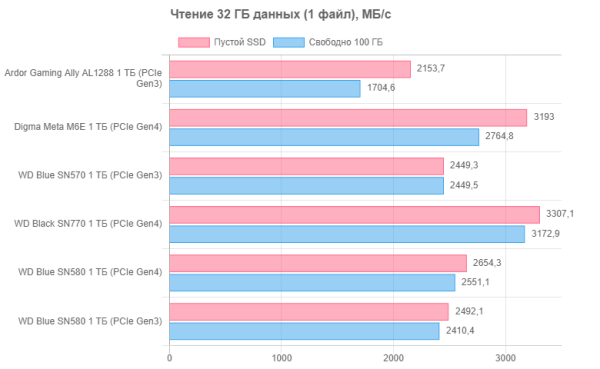
Single-thread operation is the most common, but also the most complex scenario. However, for modern controllers it has become much less complex compared to their predecessors. If we talk about budget products, they do not demonstrate any outstanding indicators. Theoretically, they could remain at the level of PCIe Gen3, but in practice, the throughput of this interface in this mode does not reach its maximum. Therefore, mastering the new version was an important step. Updating the line while maintaining the old interface did not make much sense, and this applies not only to technical aspects.
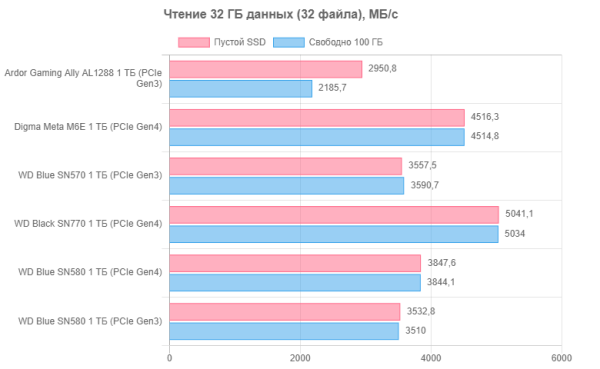
Moreover, the «cut» controller does not gain much due to the new interface. Nothing unexpected — it could have done more, but they did not give it to it. The main thing is that it is Gen4. And not a paper Gen4 — WD already had one in the form of the old Black SN750 SE.
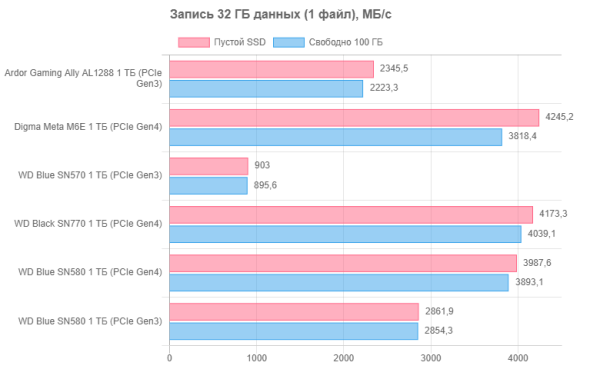
As we predicted at the beginning, the SLC cache in the Blue SN570 is too small for serious work. However, its write speed is higher than the memory itself, since part of the file fits in the cache, but no more. The other models are able to load almost the entire file into the cache, showing speeds of several gigabytes per second. Here we see an interesting effect: the difference between the SN770 and SN580 does not correspond to their specifications. When it comes to real-world work at the file level, both devices fall short of the stated figures, but the Black SN770 shows significantly better results. Thus, reducing peak speeds does not provide a noticeable advantage in practice, which probably explains why the company abandoned this approach this year, although a replacement for the Black SN770 has not yet been released.
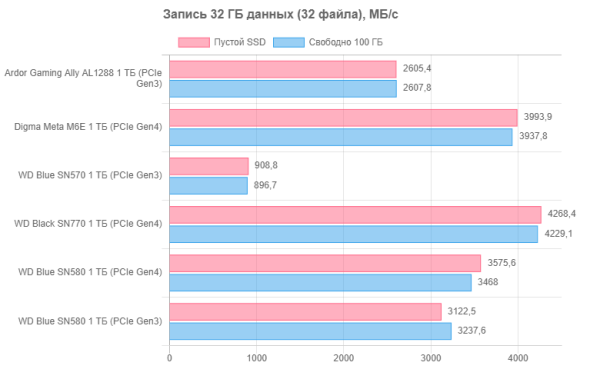
The algorithms used inside the drive become similar to those used in the previous case, but for powerful controllers, external parallelism is more effective than internal. For less productive controllers, the situation is the opposite. The two close relatives begin to differ slightly from each other, which confirms the hypothesis that the SN580 is the same SN770, but with some performance limitations. Perhaps this is simply due to the firmware. Although this is not always the case, linear scenarios are definitely the tasks where these differences can be noticed.
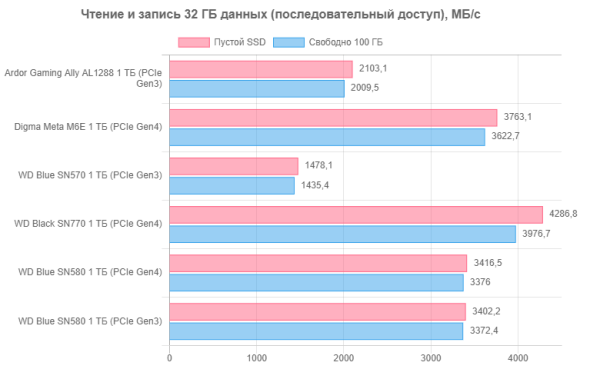
This applies to both one- and two-way scenarios, which is understandable. The SN570 did well against its competitors, but the market has changed over the last couple of years, and there is a need for new models. At the same time, they could simply release a “budget” version of the old Black.
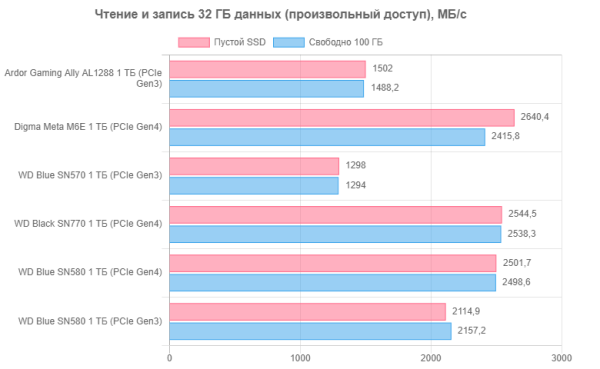
Here, looking for differences between SN580 and SN770 is a rather thankless task. The scenario itself is quite complex, and the results of all mid-range SSDs are far from peak (unlike top devices, where it is sometimes difficult to notice the difference between the last two diagrams). Therefore, «cutting» the controller's peak capabilities has practically no effect on speed.
Comprehensive performance
The best comprehensive benchmark for storage devices today is PCMark 10 Storage, a brief description of which is presented in our review. We noted that the three tests in the set are not equally useful — the best result is demonstrated by the «full» Full System Drive test, covering almost all mass scenarios: from loading the operating system to simple copying of data (both internal and «external»). The other two tests are just subsets, which, in our opinion, are not so interesting. But this test allows you to accurately measure not only the real throughput when performing practical tasks, but also the delays that occur. Averaging these metrics by scenarios and reducing them to a single number may seem a little synthetic, but, nevertheless, this is one of the closest to reality assessments «in general», and not just in specific cases. Therefore, it is worth paying attention to.
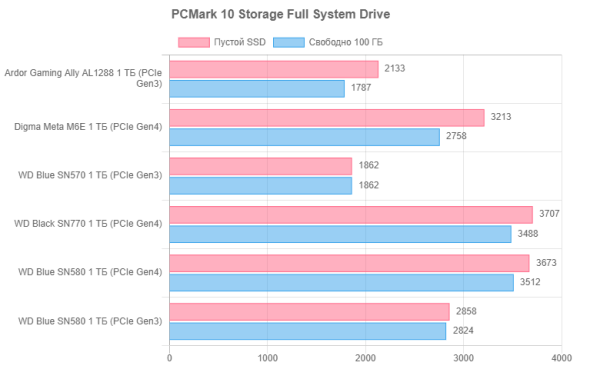
As expected, the difference in the overall score between the models is almost imperceptible. Peak sequential speeds do not have a significant impact on the overall score, and with other metrics, as we have already found out, the situation is far from clear. In addition, firmware optimization during the existence of the controller also played a role. In general, we can consider that these models are similar in the first approximation. Even in terms of potential performance — as already mentioned, the WD Blue SN570 is still quite sufficient, and in some cases even redundant. There are drives that are significantly slower, and their users do not experience any inconvenience. However, it went out of fashion last year, and competitors, both direct and indirect, began to offer faster SSDs in the same class, albeit only potentially. Therefore, the company had to respond to changes in the market without resorting to creating something fundamentally new.
Total
The WD Blue SN580 is almost an exact copy of the WD Black SN770, slightly slower in sequential access scenarios, which was expected. It is safe to say that the new WD Blue SN5000 will also be similar in speed to the Black SN770, with the exception of the 4 TB modification, which is a new model, since there were no analogs in the previous lines. This two-stage update scheme for the «blue» family did not arise by chance. Firstly, the company sought to modernize with minimal costs, using an existing solution. Secondly, the successor to the WD Black SN770 has not yet been presented. The removal of artificial restrictions from Blue this year indicates that the successor will appear soon. This model has been on the market for quite a long time, and it is time for the company to offer something more successful.
As for the usefulness of new products for buyers, a lot depends on retail prices, which are determined not only by the cost price. Usually, new models are sold at a premium, while older ones are sold at a discount. As a result, at the beginning of last year, the Blue SN580 often cost even more than the Black SN770, which made it less attractive. However, now it has become a little cheaper, and it is worth paying attention to when choosing WD products, especially in regions where the price difference is noticeable. The Blue SN5000, where it is already available, most likely will not be cheaper, so it will only be interesting after the update of the WD Black model range. But it is necessary to wait for this update and evaluate what advantages it will bring to the buyer. While there are no announcements, it is premature to talk about hypotheses.
As for the Blue family, the situation is clear. Blue SN570 can be ignored, although it is still available for sale. Blue SN5000 can not be expected. Blue SN580 is almost a complete analogue of Black SN770 and Blue SN5000. In some scenarios, it is a little slower, but it is not always possible to notice the difference in performance, even during tests. The main thing is the prices. Given equal prices, buyers will of course prefer a slightly faster device from the same manufacturer, but in the case of inequality, this provides an opportunity to save.

